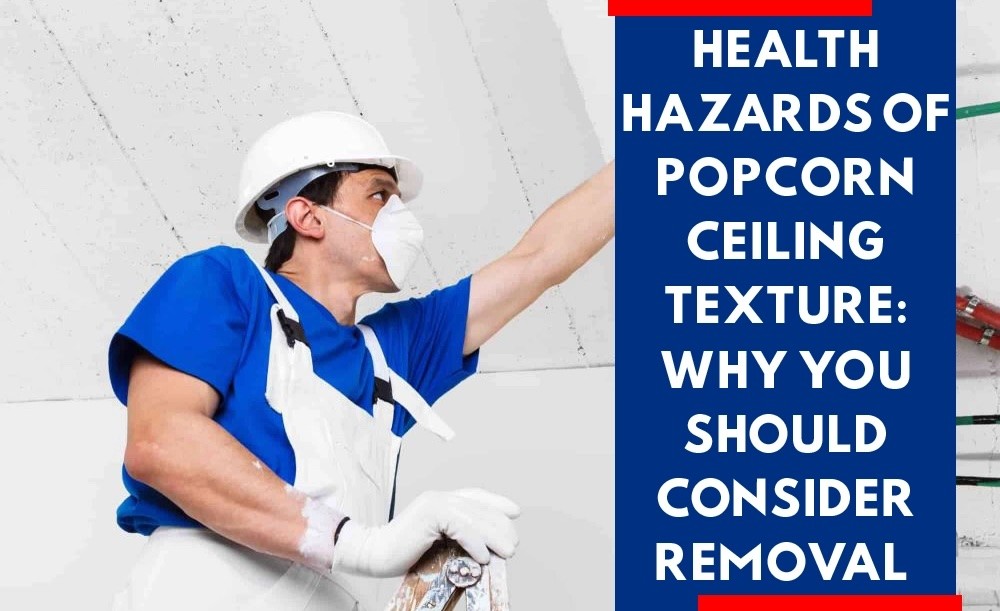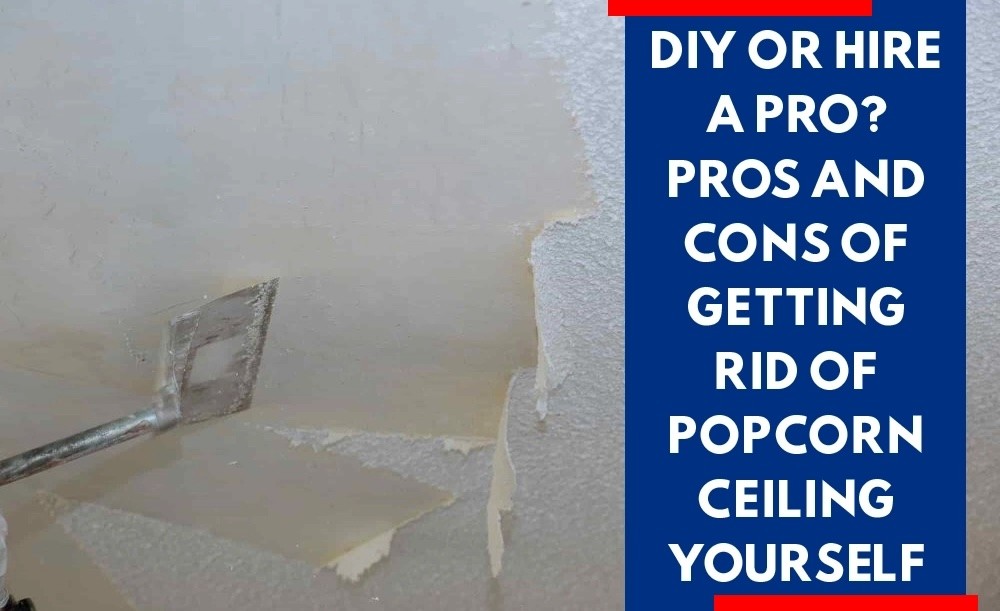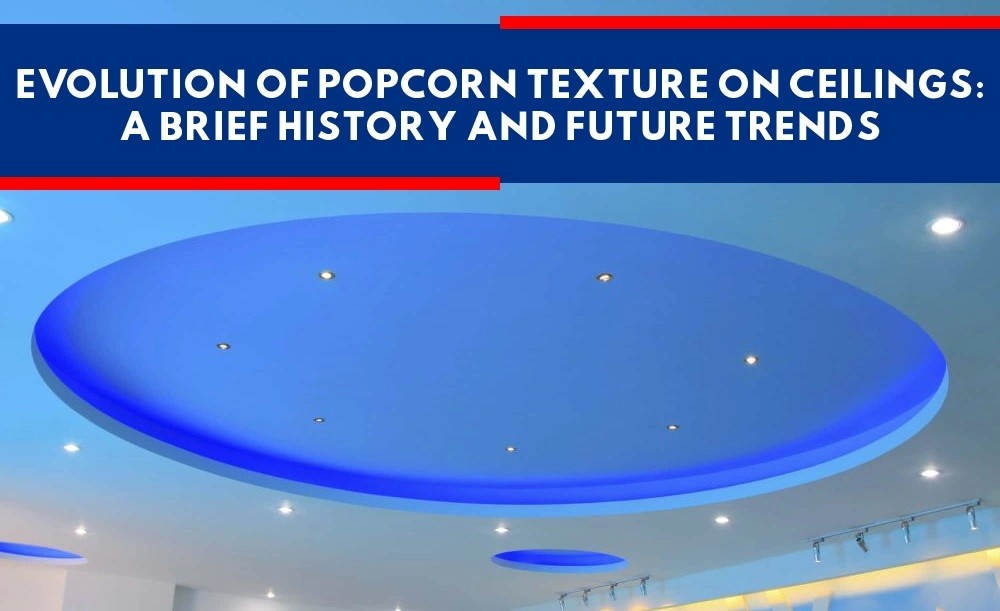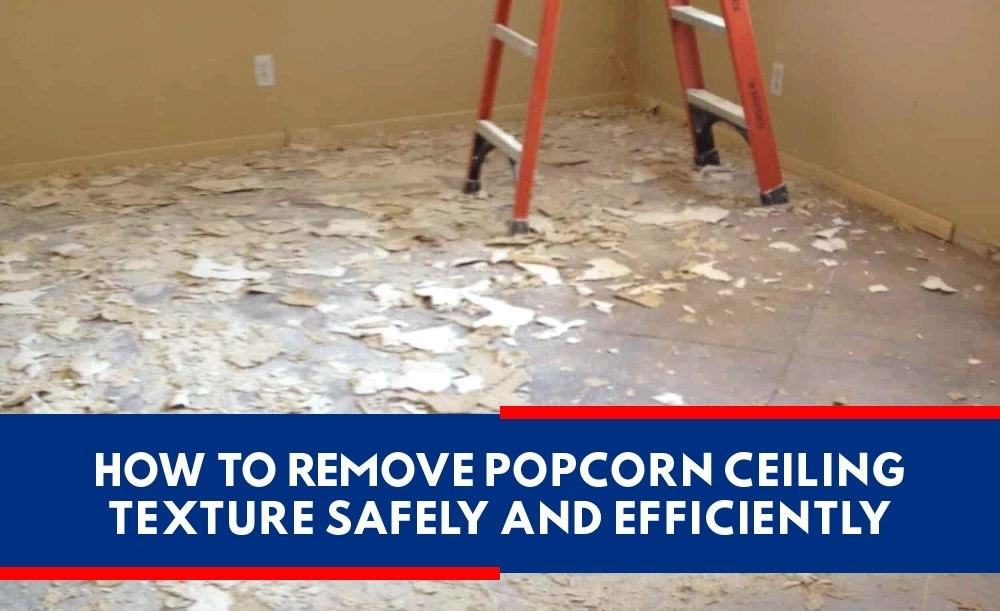DIY or Hire a Pro? Pros and Cons of Getting Rid of Popcorn Ceiling Yourself
Health Hazards of Popcorn Ceiling Texture: Why You Should Consider Removal

Table of Contents
Popcorn ceiling texture is a popular and inexpensive way to cover ceilings, but there are health hazards associated with it that homeowners should be aware of. Not only does popcorn ceiling pose a risk for respiratory problems, but it also creates an environment where mold can grow quickly and cause additional health risks. In this article, we will discuss why you should consider removing your popcorn texture if you have it in your home in Plano.
Popcorn ceiling removal services are often necessary due to the hazards posed by this type of texture. One of the most significant risks associated with popcorn ceilings is the presence of asbestos fibers, which can easily become airborne if the ceiling is disturbed or damaged. Exposure to asbestos has been linked to serious respiratory illnesses, including mesothelioma, making the removal of popcorn ceilings a top priority for Plano homeowners concerned about their family's health and safety.
Popcorn ceiling texture has been used in homes since the 1950s, but its use began to decline in the 1980s. Its name comes from its texture which resembles popcorn or cottage cheese and is created by spraying the material onto ceilings. While it was popular for many years, there have long been theories about whether or not this type of ceiling contains asbestos. Asbestos can be found in some varieties of popcorn ceiling textures produced before 1979 when the Environmental Protection Agency (EPA) banned most uses of asbestos fibers in construction materials. The amount of asbestos present varies widely depending on how much asbestos was mixed into the product when manufactured, with estimates ranging from as low as 1 percent up to 100 percent.
In order to determine if your home's popcorn ceiling texture contains any percentage of asbestos at all, you'll need to have it tested by a professional. This testing process involves collecting samples and sending them off to a lab for analysis so it's important to take precautions like wearing protective clothing and ensuring proper ventilation during sample collection. After results are received back from the lab, homeowners will know exactly what kind of health risk they may potentially face if removal isn't an option.
If your popcorn texture is found to contain any amount of asbestos fibers, the potential dangers posed to human health should be taken seriously. Asbestos exposure can lead to serious respiratory illnesses and cancers, such as mesothelioma. The risk increases with direct contact or inhalation of asbestos dust particles that become airborne when disturbed through activities like scraping or sanding during removal procedures.
The EPA recommends hiring a certified professional to handle all aspects of removing an asbestos-containing product in order to reduce the chances of contamination. This includes proper disposal techniques, protective clothing for workers, sealing off the work area from other parts of the home, and using special equipment designed to capture harmful particles before they have a chance to spread throughout the air.
In addition to these safety measures being necessary for protection against inhaling asbestos dust particles, homeowners are also advised to consider how best to protect their family's long-term health by weighing the risks associated with leaving it untouched versus having it professionally removed. Here are some key points about why you should take into account:
• Asbestos-related diseases may develop years after initial exposure;
•Removal of an asbestos-containing material requires specific safety protocols;
•Contamination of air quality inside and outside the home during removal must be avoided at all costs. It is important for homeowners and renters alike who believe they might have this type of ceiling texture in their homes to get it tested right away so that informed decisions can be made on whether or not removal is necessary. In terms of protecting one's health, prevention is always better than cure. With that in mind, next, we will look at ways in which air quality could potentially be contaminated during demolition and/or abatement projects involving popcorn ceilings textured with asbestos fibers.
The removal of dry popcorn texture mix and repair of minor surface cracks in ceilings may seem like a straightforward task, but it poses a serious health risk to Plano homeowners and contractors alike. Asbestos contamination is a potential hazard, and inhaling even small amounts of asbestos fibers can lead to severe respiratory illnesses and cancers. Therefore, it's crucial to implement appropriate safety measures before beginning any work. To protect indoor and outdoor air quality from harmful particles, contractors must take extra precautions when handling materials containing asbestos.
These measures include sealing off affected areas with plastic sheeting, wearing protective gear like face masks and gloves, using dust containment systems to capture particles, and disposing of all debris in sealed containers in accordance with local regulations. Without these steps, homeowners could unknowingly put their families at risk of inhaling dangerous fibers released into the environment during demolition projects involving popcorn ceilings containing asbestos.
When it comes to removing texture from ceilings, property owners should consider the health risks and benefits of different approaches. While concealing minor surface cracks with a dry mix or non-asbestos spray can be a temporary solution, leaving an existing ceiling untouched can still pose long-term health risks. Over time, the material may crumble or be disturbed by activities like scraping or sanding, which can release hazardous dust particles into the air. It's important to weigh these potential hazards and make informed decisions about whether or not removal is necessary.
Asbestos removal is an important part of protecting both the environment and public health. In order to ensure that asbestos-containing popcorn ceiling materials are properly abated, it's essential for contractors to follow strict safety protocols when handling them. This includes testing for asbestos in the material before beginning work so that appropriate measures can be taken to prevent any potential contamination from occurring. Additionally, all debris must be disposed of according to local regulations in order to protect air quality outdoors.
Furthermore, there may be some environmental impacts associated with removing this type of texture depending on the methods used and waste disposal practices employed during the process. For instance, if done incorrectly or without proper precautionary steps, demolition activities could result in dust particles being released into the atmosphere which can lead to air pollution and other negative outcomes. Therefore, it's vital for individuals undertaking such projects to take all necessary precautions and adhere strictly to best practice guidelines when doing so.
It's also important for property owners who decide against having their ceilings professionally removed to recognize the risks posed by leaving this type of texture in place over time due to possible exposure through activities like scraping or sanding disturbing its surface layer. Even though these hazards may not always present a direct danger right away, they should still be taken seriously as prolonged inhalation of hazardous fibers can eventually cause serious illnesses down the line. With that in mind, let us now move on to examining some risk factors associated with exposure related to popcorn ceilings.
As we have seen, popcorn ceilings present a variety of potential health hazards for those exposed to them. To better understand what these risks are and why they should be taken seriously, let's explore some key risk factors associated with exposure to asbestos-containing materials in this type of texture.
First off, it is important to recognize the danger posed by inhaling airborne fibers that may be released when disturbed surfaces on a popcorn ceiling are scraped or sanded. This can happen during renovation activities such as painting or wallpapering, but also just through regular wear and tear over time due to settling dust particles. Asbestos exposure has been linked to an increased risk of developing chronic respiratory illnesses like mesothelioma and lung cancer so minimizing contact with hazardous fibers is essential if you plan on keeping your existing popcorn ceiling material in place.
In addition, there could be other hidden dangers lurking beneath its surface layer which can only be revealed through testing – something that must always be done before any abatement work begins. Testing will help identify whether the material does indeed contain asbestos fibers or not so that appropriate safety measures can then be put in place accordingly. It is also important for individuals to keep in mind that even though new regulations have banned the use of this type of texture since 1977, older homes built prior to this date may still potentially contain it.
To summarize, identifying and managing the various risks posed by popcorn ceilings requires careful consideration: From recognizing common sources of exposure related to disturbing its surface layer; understanding how testing can reveal additional dangers; right to knowing when best practice guidelines must be followed when removing them entirely - all these points should factor into the decision-making process when deciding whether removal is necessary or not.
Popcorn ceiling texture is an outdated, hazardous material that poses many potential risks to human health and the environment. It can release particles into the air, contaminate indoor air quality, and cause long-term respiratory problems in both adults and children. While it may seem like a simple job to remove popcorn ceilings, the process should not be taken lightly as it requires specialized knowledge of asbestos removal techniques. The bottom line is that if you have any doubts about your popcorn texture being safe for your home or business, then don't hesitate to contact a professional for further advice. In addition to protecting yourself and others from these dangerous contaminants, you'll also be helping protect our planet by reducing the number of pollutants released into the atmosphere every day! So make sure you do your due diligence when considering whether or not to keep your popcorn ceiling – because at the end of the day, it just might save lives!
Author

Mason Marquis, raised in Newport Beach, California, and Austin, Texas, amalgamated his experiences from both vibrant cities in his journey. His academic pursuit in Economics and Psychology at the University of North Texas (UNT) led to the founding of Spray Tex Painting. This venture was not just a business for Mason but a practical application of his academic learnings, particularly the integration of economic concepts and psychological understanding. Spray Tex Painting, under Mason's direction, transcends being merely a painting service; it's a platform where client visions are realized through dedication and creativity.
Related Articles

DIY or Hire a Pro? Pros and Cons of Getting Rid of Popcorn Ceiling Yourself

Evolution of Popcorn Texture on Ceilings: A Brief History and Future Trends

How to Remove Popcorn Ceiling Texture Safely and Efficiently

Popcorn Ceiling Texture Spray Alternatives: What Are Your Options?